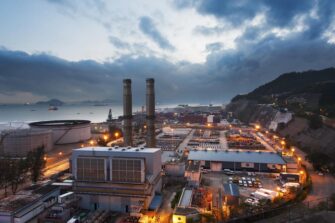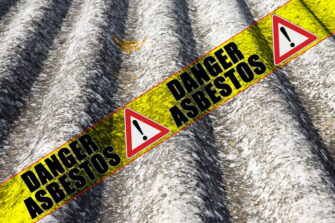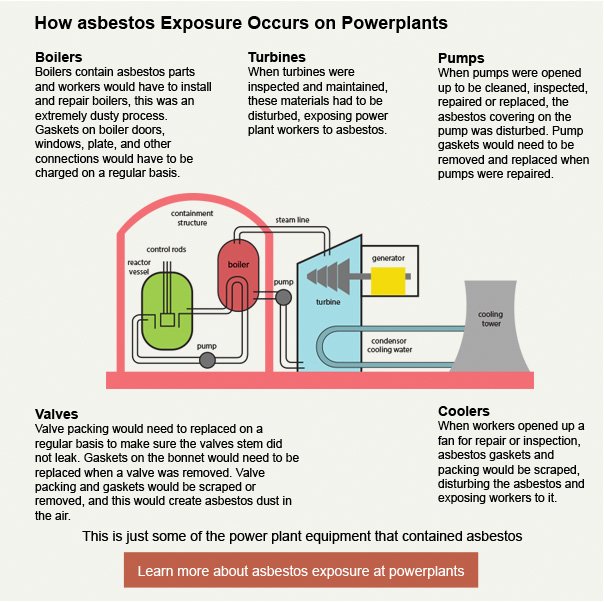Asbestos Exposure at Niagara Mohawk Power Corporation

Niagara Mohawk Power is an electricity and natural gas supplier to about 1.6 million customers in upstate New York that has its roots in the hydroelectric potential of the region’s many rivers.
It was acquired by National Grid in 2000 and continues to operate as Niagara Mohawk Power Corporation.
Former Niagara Mohawk plant workers may develop mesothelioma or lung cancer from being exposed to asbestos through the course of their employment. If you have been diagnosed with mesothelioma or lung cancer, contact Belluck & Fox, LLP for a free case review.
Specific Power Plants
Table of Contents
Dunkirk Steam Station New York
Years of Operation: 1950-Present
Address: Dunkirk, New York
Dunkirk Steam Station is a coal-fired power plant situated on an 84 acre site on Lake Erie in Dunkirk, New York, about 50 miles southwest of Buffalo. The station was acquired by NRG, Inc. in 1999. New York State officials approved a plan in 2014 to repower Dunkirk with natural gas, a move that’s expected to lower both fuel costs and pollution.
The 600-megawatt Dunkirk plant consists of four coal-fired units that went into operation between 1950 and 1960. As of December 2013, however, the plant only operated one unit due to the high cost of coal.
In 2012, NRG filed a notice of intent with the New York State Public Service Commission to shut down all four units over cost concerns, but a $140 million agreement between NRG and utility provider National Grid to repower Dunkirk with natural gas ultimately saved the plant, along with around 70 jobs and considerable tax revenue. NRG is the largest taxpayer in Chautauqua County and is responsible for more than 40 percent of Dunkirk’s annual property tax revenue.
Environmental group the Sierra Club and a community group called the Ratepayer and Community Intervenors responded to the plan by filing a lawsuit seeking to put the natural gas conversion plan on hold. The suit claims that taxpayer subsidies for the project will result in unnecessarily high electric bills for customers and that the environmental review of the plan was flawed.
Huntley Station
Years of Operation: 1916-Present
Address: Tonawanda, New York
The Huntley Generation Station is a coal-fired power station located in Tonawanda, New York, just outside of Buffalo. It is owned by NRG Energy, which bought the station from Niagara Mohawk Power Corp. in 1999. Huntley Station is one of the few remaining coal-fired power plants in New York and was once Niagara Mohawk’s largest coal-fired plant.
Construction of River Station—the original name of the plant—began in January 1916 by Buffalo General Electric. The station name was changed to the “Charles R. Huntley Station” in 1926 to honor the death of the Buffalo General Electric president. The facility later became part of the Niagara Hudson System.
Despite investments by NRG geared towards reducing pollution from Huntley, the plant led the list of biggest polluters in Erie County each year between 2002 and 2011 and again in 2013.
Glenmont Powerhouse (Albany Steam Station)
Years of Operation: 1952-2005
Address: Bethlehem, New York
Niagara Mohawk Corporation began operating the Albany Steam Power Station in Glenmont, New York in 1952. Originally a coal-fired station, it was converted to oil in 1970. Additional modifications in 1981 allowed the plant to also burn natural gas and raised its total capacity to 400MW.
PSEG Power LLC purchased the Albany Steam Station from Niagara Mohawk in 2000 for $47.5 million and subsequently announced plans to build a new facility—the Bethlehem Energy Center (BEC)—on the site to replace the existing plant. Construction of the BEC plant began in 2002 and commercial operations began there in July 2005.
The Albany Steam Station was decommissioned in February 2005, but the new plant uses the old plant’s switchyard. It also uses the old plant for its electrical shop, maintenance shop, and instrumentation and control shop.
PSEG sold everything of value in the Albany plant, including steel, pumps and motors, and condenser tubing. PSEG is responsible for maintaining the old plant’s encased and tagged asbestos in its encapsulated condition. All other asbestos was previously removed.
Oswego Steam Station
Years of Operation: 1956-Present
Address: Oswego, New York
The Oswego Steam Station is located on a 91-acre plot on Lake Ontario’s shores in Oswego, New York. It consists of four steam-powered electric generators capable of producing a total of 407 megawatts of power.
Niagara Mohawk Power Corporation began construction of the units in 1938 and completed the fourth unit in 1956. The four units were originally designed to be coal-powered but began using oil in 1972.
Niagara Mohawk announced the sale of its 88 percent stake in the steam power station to NRG Energy, Inc. in 1999 for $80 million. National Grid Group PLC, a British power company, purchased the remainder of Niagara Mohawk’s holdings and debt for a total of $8.9 billion on September 5, 2000.
Nine Mile I & II
Years of Operation: 1970-Present
Address: Scriba, New York
Nine Mile Point is a two-unit nuclear power plant located in Scriba, New York (about 40 miles north of Syracuse). Both units were formerly owned by Niagara Mohawk, which sold them off in an effort to become a slimmer company.
Nine Mile I first provided power to area homes and businesses in 1969. The Oyster Creek Nuclear Generating Station in Forked River, N.J. and Nine Mile I are the two oldest nuclear power plants in the U.S.
Nine Mile II was issued its operating license in 1987. Its rated power capacity of 1,148 megawatts is nearly double the output of Unit I.
In 2001 Constellation Energy Group completed its purchase Of Nine Mile I from Niagara Mohawk. As part of the same deal, Constellation also bought 82% of of Nine Mile II, including Niagara Mohawk’s 41% stake in the plant. The remaining 18 percent of Unit 2 is owned by the Long Island Power Authority.
FitzPatrick Nuclear Power Plant
Years of Operation: 1975-Present
Address: Scriba, New York
The James A. FitzPatrick Nuclear Power Plant is an 838-megawatt boiling water reactor (BWR) located on the same 900-acre Scriba, N.Y. site as the Nine Mile Point Nuclear Station. It is named after James A. FitzPatrick, who served as Power Authority chairman from 1963 to 1977, the longest tenure in the Authority’s history.
The New York Power Authority trustee granted contracts to Niagara Mohawk Corporation and GE to begin construction of the site in 1968. The plant was issued its operating license in October 1974 and began commercial operations in 1975.
In 1987 the Power Authority announced its intention to build the Sound Cable Project, a 26-mile underground and underwater transmission line that would allow electricity generated in upstate New York to flow from Westchester County to Long Island.
The state Public Service Commission approved the plan in 1988 and in 1991, the Sound Cable Project began delivering electricity to several Long Island businesses. The cheap energy provided by the FitzPatrick nuclear station helped protect thousands of jobs in Suffolk and Nassau counties.
FitzPatrick reached the 100 billion kilowatt-hour lifetime power generation mark on January 15, 1998 and was sold to Entergy Nuclear in November of 2000. It remains one of the largest employers in, and a significant economic contributor to, Oswego County.
History of Niagara Mohawk


During the 1950s Niagara Mohawk purchased 83 hydroelectric plants, seven steam generators, and thousands of miles of gas mains. In the 1960s it undertook several major upgrades in these facilities to meet expected increases in the demand for electric power.
In 1965 the company received permission from the US Atomic Energy Commission to build an atomic generator to produce more electricity. Construction began on the Nine Mile Point nuclear facility in Oswego, New York, which sits on the shores of Lake Oswego. It announced that it would begin construction on a second nuclear plant, Nine Mile Two, in 1970 and build a sixth oil-burning unit at Oswego in 1972.
The energy crisis of 1973, which raised the price of raw petroleum needed for energy generation, took a huge toll. Consumer demand dropped in reaction to price increases, and the company was forced to sell off some of its holdings, lay off staff, and scale down construction plans.
Construction on the Nine Mile Two nuclear plant and the oil burner at Oswego slowed, but were never entirely halted. Nine Mile Two was finally completed in 1988.
During this period the first reactor developed cracks which forced periodic closures. Financial strains, investor exits, and mismanagement led to a decision to sell off all power generators and focus solely on electricity distribution.
Between closures, repair costs, and cost overruns for Nine Mile Two, Niagara Mohawk entered the 1990s with serious financial issues. It sold its Huntley and Dunkirk coal stations to NRG in 1999 and agreed to sell Nine Mile One to Constellation Energy (which also purchased 82% of Nine Mile Two) in 2000. Later that year the British firm National Grid PLC acquired Niagara Mohawk Holdings. The merger was completed in 2002.
Today, Niagara Mohawk Power is primarily an electricity transmitter and distributor. Its headquarters are located in Syracuse, New York.
Niagara Mohawk and Asbestos Exposure


Additional asbestos-containing materials at Niagara Mohawk included pipes, compressors, conveyors, heaters, soot blowers, and evaporators.
The use of asbestos at Niagara Mohawk facilities created a significant risk of asbestos exposure among workers. Pipefitters, electricians, maintenance mechanics, boiler operators and tenders, plumbers, welders, and laborers were all likely exposed to asbestos when they installed, inspected, maintained, repaired, and replaced plant equipment.
Exposure also occured during scheduled maintenance shut-downs and upgrades (e.g. when plants converted from coal to oil or from oil to gas), as materials were disturbed and asbestos became airborne. Some of this asbestos dust may also have been carried home on clothing or skin and subsequently breathed in by workers’ loved ones.


Asbestos Exposure and Mesothelioma
Asbestos exposure is the only known cause of mesothelioma, a cancer that affects the lining of the lungs, abdomen, and heart. It can take 15 to 60 years for mesothelioma symptoms to develop following exposure in the distant past, making the disease difficult to diagnose. There is no cure for mesothelioma and treatment options are limited, although early diagnosis correlates with better patient outcomes.
Asbestos can also lead to lung cancer and asbestosis, or scarring of the lungs caused by asbestos fibers. Because all asbestos-related disease is serious, visit your doctor immediately if you ever worked at Niagara Mohawk and are now experiencing chest pain, shortness of breath and a persistent cough, or other mesothelioma symptoms.
What Action You Can Do If Diagnosed With Mesothelioma
Belluck & Fox, LLP is a team of nationally recognized mesothelioma attorneys with over two decades of experience litigating asbestos-related claims. We have represented former Niagara Mohawk plant workers who developed mesothelioma and lung cancer.
We’re familiar with where asbestos was located in their plants and which companies supplied asbestos products to Niagara Mohawk. These companies failed to warn workers about the health risks of asbestos and through legal action, they can be held accountable for victims’ medical bills and other losses.
Contact Belluck & Fox, LLP today to learn how we can obtain justice for you and your family. You can also visit our New York law office.
Another case of asbestos exposure happened in another company called Rochester Gas Electric and Long Island Lighting Company (LILCO) . Know more About it.
